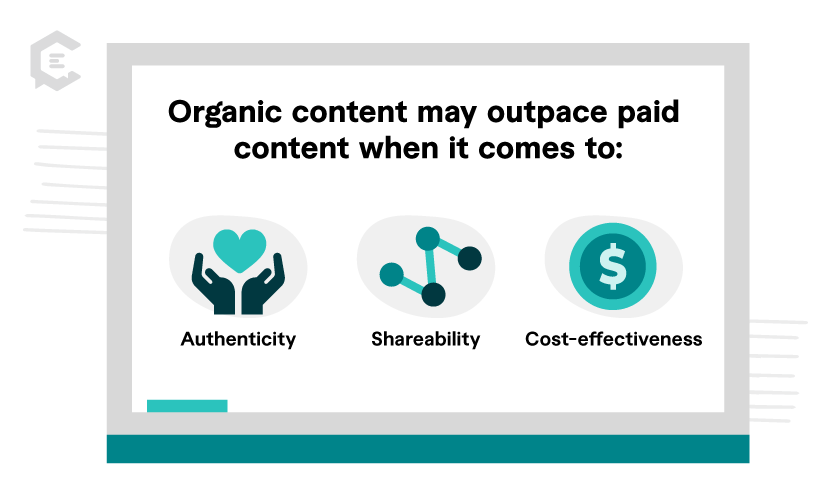What is organic content?
Organic content is content that’s created and distributed without paid promotion or advertising. It’s designed to generate visibility, engagement, and conversions through natural, non-paid means.
For example, to attract more traffic to your website, you conduct some keyword research. Through it, you find that a lot of people are searching for “best exercises to lose belly fat.” Based on that information, you create a blog post titled “10 Best Exercises to Lose Belly Fat.” Then, you include a variety of exercises that have proven effective when torching belly fat.
After that, you optimize your post with relevant keywords and share it on your social media accounts. Over time, your post begins to gain traction and rank higher in search results for the targeted keyword phrase.
As a result, you attract more traffic to your website. Simultaneously, you establish your brand as a trusted resource for fitness information. To top it off, you start generating leads and sales from increased exposure. That’s how effective organic content can be a rocket ship for your brand.
Why is organic content essential to your strategy?
Optimized organic content can improve your search engine rankings. That makes it more likely that your website and content will appear in relevant search results.
The numbers agree: The #1 organic result in a Google search has a click-through rate of 27.6%, while paid ads only deliver a click-through rate of 3.17%.
What does this all mean? Consumers value authenticity. They’re more likely to engage with high-value content designed to meet their pain points over ads designed to get them to spend money.
Organic content is also often evergreen, meaning it remains relevant and valuable over time. While some content may require periodic updates, a substantial portion of your organic content can continue to attract and engage audiences long after its initial publication.
What makes good organic content?
Good organic content is well-written, informative, and engaging. It provides value to your target audience by solving problems, addressing pain points, and answering questions.
It also uses relevant keywords, whether in the body of written text or the description of images and videos. And because people value originality, it’s often best to get creative with your content ideas.
Examples of effective organic content include the following:
How-to guides
Creating informative how-to guides that provide value to your audience can be a great way to generate organic traffic to your website. For example, a manufacturing company might create a how-to guide on using a particular feature of one of its products.
Infographics
Infographics are a visually appealing way to present complex information in a simple, easy-to-understand format. They can be shared on social media, embedded in blog posts, and used to generate backlinks to your website.
User-generated content
Encouraging your customers to share their experiences and stories about your brand can be a powerful way to generate organic content. That can include customer testimonials, product reviews, or user-generated photos and videos.
Social media posts
Sharing engaging, visually appealing content on social media can help increase engagement and build a community of followers. It can be behind-the-scenes photos and videos, informative posts, or entertaining memes and GIFs.
Organic content vs. paid content
While both organic and paid content can drive traffic to your website, there are some critical differences. Paid content involves paying for advertising space or promotion. Organic content is designed to attract traffic naturally. Paid content can quickly boost traffic. Organic content focuses on building long-term relationships with your audience.
In some situations, organic content can outperform its paid counterpart. For instance, organic content may outpace paid content when it comes to:
- Authenticity. Organic content is often more authentic and genuine than paid content. And people tend to trust and engage with content that feels authentic and comes across as real.
- Shareability. Organic content is more likely to be shared and amplified by audiences, which can help increase reach and engagement. That’s because people share content that they find interesting, informative, or entertaining with their networks.
- Cost-effectiveness. Organic content is usually less expensive than paid content. Because it costs less, it’s an excellent option for brands with limited marketing budgets.
Organic content best practices and strategies
To create effective organic content, it’s essential to follow best practices and strategies designed to maximize impact. Some key strategies to consider include:
Conducting keyword research
Before creating any content, conduct keyword research to identify the keywords and phrases your target audience searches for.
Creating high-quality content
Your content should be well-written, informative, and engaging. Make sure to provide value to your audience by answering their questions and addressing their pain points.
Optimizing your content
Use relevant keywords in your headlines, subheadings, and the rest of your content. It’s also best to incorporate tags and meta-descriptions for images.
Promoting your content
Share your content on social media and other relevant platforms to increase its visibility and attract more traffic. Avoid keyword stuffing. Google’s algorithm frowns on content jam-packed with keywords designed to give pages higher rankings.
Start leveraging organic content today
Creating effective organic content can help you achieve success in the digital age. It’s authentic, shareable, and cost-effective. And it can provide long-term value and benefits for your brand.
To unlock the potential of an organic content strategy for your business, reach out to ClearVoice today. We’re happy to help.






